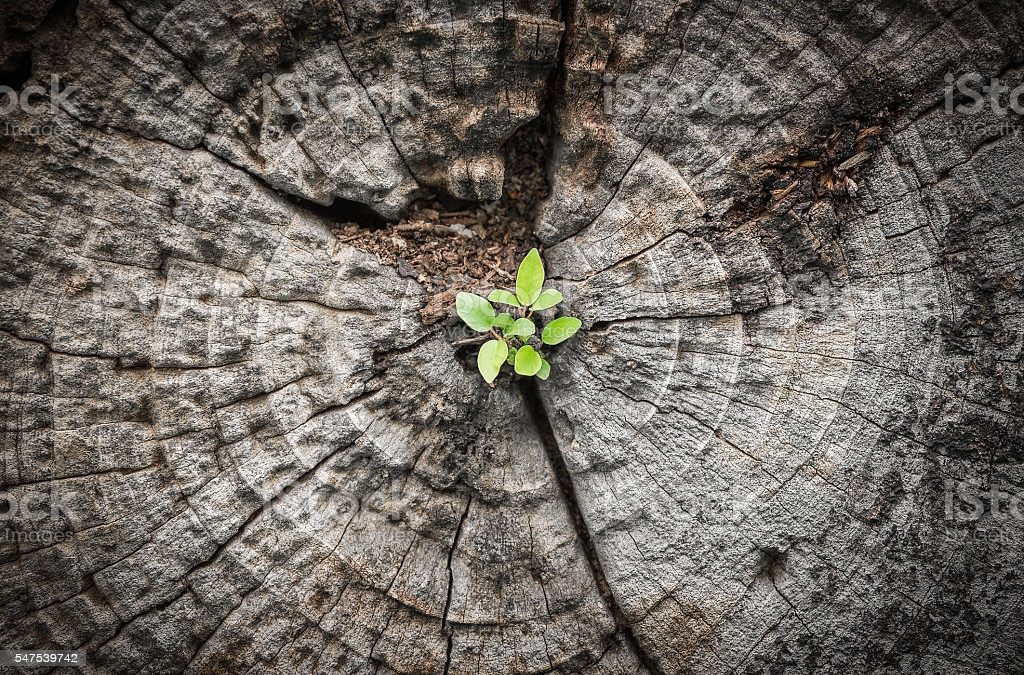Written by Admin and published on https://worstroom.com/
Trees are living things that live, get sick, and will eventually die; just like human beings. However, when a beloved tree begins to deteriorate, you shouldn’t lose hope! Let us help you! This article will guide you on how to save a dying tree.
Trees add life as well as color to your garden. They do not only provide flowers, fruits, and shade but also serve as homes to beautiful birds and other animals.
A healthy and beautiful tree can be a real prized ornament in your garden or backyard. However, this is just one side of the story! On the other hand, a sick and dying tree is something that you should be concerned about.
How to Save a Dying Tree: Easy Tree Health Success

It’s a rare event that a tree gets sick. If you’re wondering how to save a dying tree, you’re one of the unlucky, but it’s not a random roll of the dice.
Most trees, once established and mature, have the ability to fend off disease, problems associated with insects, and extreme weather conditions.
But once a tree’s health is compromised, it becomes vulnerable to all of the above problems, making it crucial to act as soon as possible. I’ll help you identify the problem and provide some actionable steps you can do to restore your tree to full health.
Learning how to revive a dying tree is the hard part, but we’ve made it easy here. The easy part is the healing process.
How to Save a Dying Tree
First and foremost you need to confirm that your tree is, infact, dying. Below this section I list out the signs of a dying tree that will help you confirm the problem. Second, you need to identify the specific problem.
Sometimes taking the general steps in this section is enough to help the tree get enough strength to ward off the illness itself. Other times you’ll need to apply some specific actions, which we point out below.
These can include pesticides, restoring macronutrients to the soil, and more. In the worst case scenario you can consult a professional arborist.
Correct Moisture Problems
Mature trees tend to be able to survive dry seasons or even overly wet ones. Younger trees can face issues associated with too much or too little water.
Over-watering is often a weather issue and not one you’re creating by watering the lawn. It has to do with the drainage of the soil around the tree.
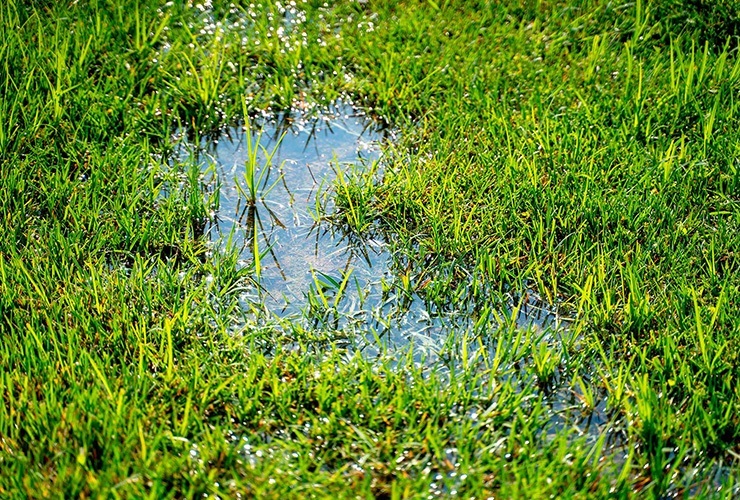
Look for water-logging, where the roots of the tree have become soft and soggy. Other signs include the growth of various types of moss and molds on the dirt around the tree and a lack of grass.
If the soil around the tree is constantly saturated with water, this is a problem and you need to work on getting water to drain away from that area or introduce more sunlight.
If you believe under-watering is the issue, this is easy to solve with a garden hose or an automatic or alternative sprinkler system. You can even fill up a five-gallon bucket with water and carry it to the tree. Whatever it takes for our friend to feel better!
Don’t Add to Much Mulch
Mulch is not bad, but there’s a common problem where people tend to build up a cone around the base of the tree using mulch. I’m not sure why, but so many people do this. There are a ton of problems associated with this:
- The roots can’t breathe
- The roots and trunk can begin to rot
- Insects, fungi, and bacteria will infest and infect the area
If you’re placing thick layers of mulch around the tree, simply thin that area out. If you’ve allowed mulch to build up around the base of the trunk, you need to remove all of it.
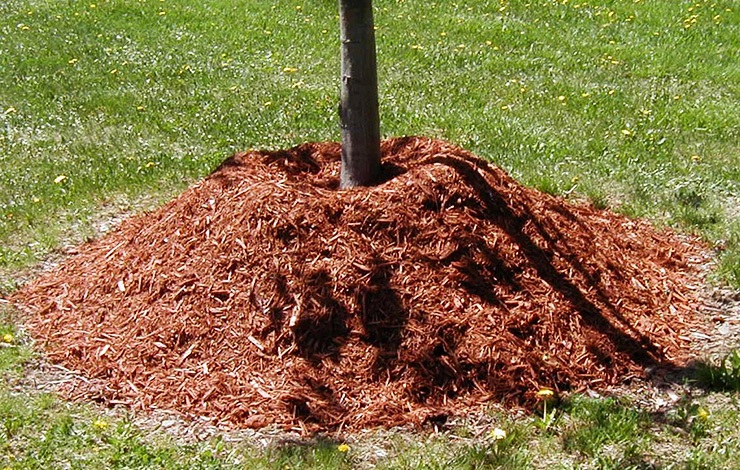
The same goes for fertilizer. Don’t build up a mound around your tree! Fertilizer especially can have ill effects, such as “burns” due to the chemical makeup.
Use the Right Fertilizer
Many people just buy an all-purpose fertilizer and chuck around the tree like mulch. That can be fine but it can also be deadly. What you really need to do is perform a soil test in the area of the dying tree and find out exactly what macronutrients are missing.
These are nitrogen, phosphorous, and potassium, which are what the fertilizer numbers represent on the front of the bags.
Just like mulch, too much fertilizer can allow all kinds of bad bugs and bacteria to make a home around the roots of your tree, which you can think of as the tree’s mouth. We don’t let bugs make a nest around our mouths any more than we should allow that for a tree.
Direct contact of the fertilizer on the roots can also “burn” them chemically, so go light if you’re sprinkling it that close to the tree.
Prune the Sick Limbs
This is tricky because it’s hard to know how far a disease has spread, but it is possible to remove visibly diseased areas from an otherwise healthy tree. By pruning limbs or even sections of bark and trunk, you can stop the illness from spreading.
Make sure, after doing this, that you sterilize your shears, saws, and knives you used to perform the job.
Make sure you research how to prune the type of tree you’re working with. There are various pruning techniques that are appropriate for specific species of trees. Severe pruning can send the tree’s system into shock, and it’s already struggling, so please take care when doing this.
Signs of a Dying Tree
Before you start going to work to save a tree, you need to make sure it actually needs saving and you’re not being overly cautious. There are some obvious signs a sick tree will give.
Dried Leaves
If a tree’s foliage becomes crunchy or loses its leaves during the spring or summer seasons, that’s a sign there is a problem. But don’t overreact during the autumn or winter months.
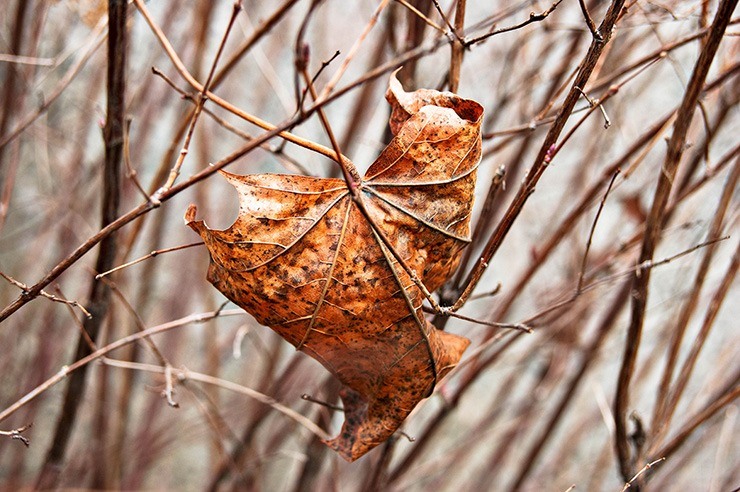
You may notice some branches are completely healthy and full of leaves while others are scanty, or that the entire tree has less leaves than others of the same species at the same time. That’s a bad sign.
Weak Branches
Sometimes the leaves may be doing fine but you notice the branches are starting to sag under their own weight. This happens especially with trees with many and heavier leaves, like the types of willow trees, for instance.
If you see the branches losing strength and sinking under the weight of their own sub-branches and leaves (and even worse during and after a rain), then your tree is likely sick to some degree.
Focus your attention where the branches split off into child branches. Do these joints seem like they could break eventually? Poor joints are a bad sign.
Dried Branches & Trunk
Branches should bend some, even in more naturally brittle trees. Check to see if the branches are still pliable. If they begin to crack and snap far too soon, then you’re looking at deadwood.
All trees have elasticity, even in the trunks, or they wouldn’t be able to survive most winds. A lack of elasticity is a very bad sign.
Softness & Decay
If you find softness and decay that’s not related to water-logging, this is a very bad sign that your tree is dying, because it’s not fighting off disease, bacteria, and fungus.
Some fungus or mushrooms growing on the trunk and roots can be fine. But you’ll know there’s a problem when entire areas have become extremely soft to your touch.
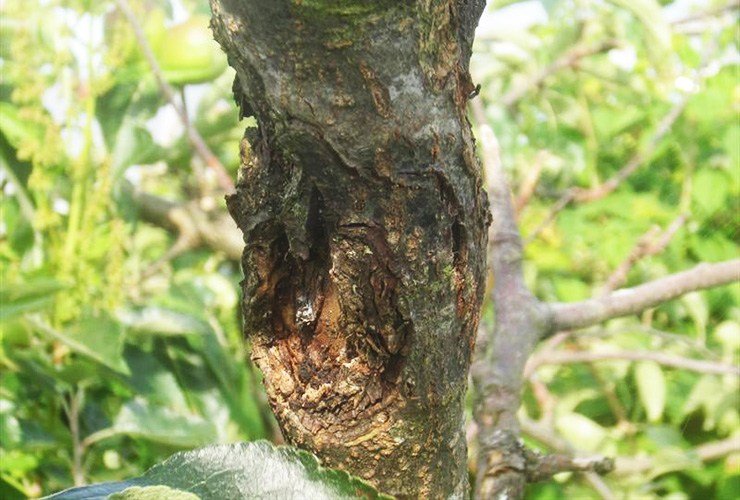
Look for what are called “cankers,” which are sores caused by bacteria and fungi that infect the tree, creating an open wound.
You need to prune these areas soon, because then the illness can penetrate deep into the tree and get beyond the exterior defenses. This stress will make the tree far more vulnerable to other problems.
Leaning Tree
When a tree is dying, the root system becomes weak and the tree can start leaning. I’m not talking about a younger tree growing towards the sun, but the entire structure leaning to one side from the roots and up.
This is because the roots aren’t able to hold it in place in the soil, a big sign there’s an illness involved.
Saving a tree that is leaning isn’t worth attempting. You should consider having it removed, especially if it is leaning towards your house, garage, carport, or those of a neighbor. It’s unfortunate but safety matters more.
Can a Dead Tree Be Revived?
Can a half dead tree be saved? Yes, that’s basically what we’ve been talking about. But can a dead tree be revived, as in a fully dead tree?
Sometimes you can do your best and experience new leaf and branch growth starting lower near the base, spawning off of new roots or a revived root system. But in general, no, you won’t revive the entirety of the tree.
Causes of a Tree Dying
We mentioned above about over and under-watering, a lack of soil nutrients, mulching and fertilizer issues, and disease. Established trees are resistant to most everything, including these problems, except for the worst diseases.
Here are a few common diseases you may encounter:
American Chestnut Blight – Caused by the pathogen cryphonectria parasitica, it can cause sunken cankers, orange-colored spots along branches or the trunk, and even cause yellow spores to be emitted.
Professionals can apply a soil compress cure or a hypovirulence transfer.
Powdery Mildew – Caused by fungi in the order Erysiphales, it starts on the leaves of the lower branches and works its way up the tree from there.
It grows a white, powdery layer over fruits and leaves, which eventually turn gray and then black. Fungicides like triademefon and propiconazole will end this disease.
Sudden Oak Death – Caused by a pathogen named phytophthora ramorum, the most outward symptom is that the bark of the trunk will split and begin weeping a dark brown sap.
Eventually the leaves and newer shoots lose their color and wilt. The five-week treatment consists of spraying a phosphonate-based surfactant on the trunk.
Dutch Elm Disease – Caused by the ascomycete microfungi spread by the American bark beetle, this disease spreads to other trees quickly through the root system underground.
Symptoms include wilting and yellowing of branches and leaves starting at the crown and moving down to the base of the trunk. The course of action is to prune the infected limbs and apply a fungicidal injection.
Fire Blight – Caused by erwinia amylovora, this disease affects fruit trees mainly, making them take the appearance of a burnt tree. Affected trees will shrink in size and become blackened.
Professionals suggest pruning affected areas as early as noticed and spraying the tree with antibiotics like terramycin and streptomycin.
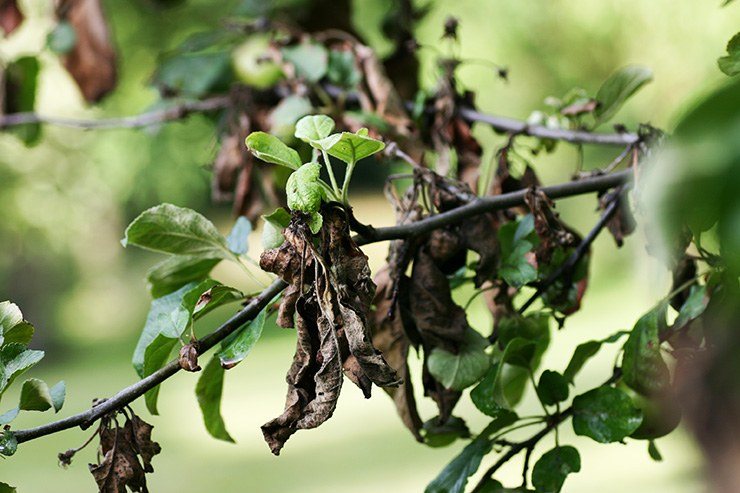
Those fruit trees not planted during the best time to plant fruit trees will be a bit more vulnerable until they’re established, though any can succumb to this disease.
Tips to Keep Your Tree From Dying
Here are some additional tips to boost the health of your tree in addition to those mentioned above. During the dry winter months, trees require little to no nitrogen but still need phosphorous and potassium.
Consider creating a liquid solution of 0-20-20 fertilizer and watering it directly to the tree’s roots.
Try to avoid running over exposed tree roots with your lawn mower. Cutting the tops of the roots down creates injuries that invite bacteria and fungi into the tree’s system. In the same vein, avoid using weed killers near your trees.
Once you prune an ill tree, make sure to sterilize the equipment before working on another tree of plant or you risk introducing the disease to more trees. Watch out for water-logging in areas with poor drainage, and the same goes for over-watering on your part.
Too much mulch around your trees means there won’t be enough drainage and the roots won’t have access to air easily.
Is My Tree Dying or Dormant?
Obviously a dormant tree is not dead, just in a state of low growth and preservation, similar to hibernation. It’s easy to confuse the two due to the most outward symptoms of both being similar, in which leaves wilt, dry up, and fall away.
If you’re trying to determine how your tree is doing, and it’s late autumn or during the winter, you either need to wait until the spring to make a determination or hire an arborist to visit and run some tests. There are a few small tests you can run yourself.
See if the branches will still bend without snapping or cracking. If it does break, check the inside of it to see if it is totally dry or if there are signs of life within. You can scratch away the bark of the branch and see if there is any greenish growth beneath.
Consult an Arborist
In a worst case scenario you can contact an arborist, which is basically a tree doctor. They can run tests on specific trees, identify at-risk trees, spray with preventative chemicals, and brace your trees for added support.
They can also help with pruning, alert you about symptoms of diseases spreading in the area, inform you about the laws in your county for deforestation and using chemicals, and can even let you know if you have any valuable trees you could sell for lumber.
They’re also qualified to climb up your trees, use heavy equipment when removing dead trees, and more.
If you’re unsure about anything but value your trees too much to stand losing them, then definitely consult a local arborist.
How to Bring a Dying Tree Back to Life
When trying to salvage a dying tree that’s having issues from anything but a serious disease, the tips above will be more than enough. For those with big, problematic diseases, you’ll need to contact an arborist to get a real medical treatment in place.
And remember, you can revive a sick tree, but not a dead one. Accepting that sooner than later can save you from it falling over and costing you a lot of money.
Original post here https://worstroom.com/how-to-save-a-dying-tree/.

